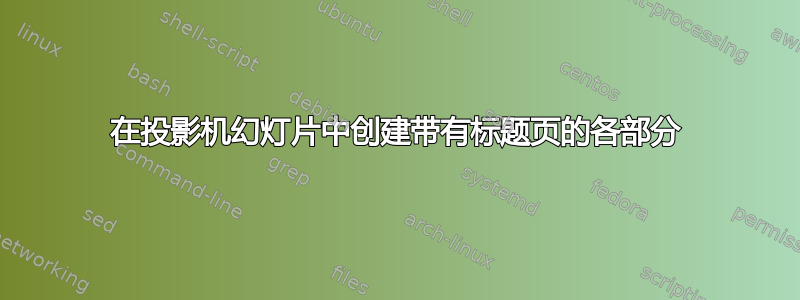
我正在写论文答辩幻灯片。我想为三个章节各制作一个标题页。具体来说,我希望在进入该部分时能够复制每个章节的论文标题所在的框。我不想要的东西:我的名字、大学和日期。那么,如何才能将每个章节的标题放在与主标题相同的样式框中呢?提前致谢。
\title{This style box is what I want to replicate three other times in the slides.}
\author[Not needed]
\institute{I don't want this.}
\date{I don't want this either}
答案1
只需将带有章节标题 ( )的\AtBeginSection放置在 a 内部即可轻松完成此操作:frame\insertsectionheadbeamercolorbox
\documentclass{beamer}
\usetheme{Madrid}
\AtBeginSection[]{
\begin{frame}
\vfill
\centering
\begin{beamercolorbox}[sep=8pt,center,shadow=true,rounded=true]{title}
\usebeamerfont{title}\insertsectionhead\par%
\end{beamercolorbox}
\vfill
\end{frame}
}
\title{The Title}
\author{The Author}
\institute{The Institute}
\begin{document}
\begin{frame}
\maketitle
\end{frame}
\section{Test section one}
\begin{frame}
test frame for section one
\end{frame}
\section{Test section two}
\begin{frame}
test frame for section two
\end{frame}
\end{document}

可能取决于所使用的主题(问题中未提及),您需要调整框的设置;特别是,您可能需要通过将其设置为来停用该选项shadow和/或。roundedfalse
答案2
我正在看同样的事情,并且下面的大纲也可能有用。
\documentclass[english]{beamer}
\usepackage{lmodern}
\renewcommand{\sfdefault}{lmss}
\renewcommand{\ttdefault}{lmtt}
\usepackage[T1]{fontenc}
\usepackage{amsmath}
\usepackage{amssymb}
\makeatletter
%%%%%%%%%%%%%%%%%%%%%%%%%%%%%% Textclass specific LaTeX commands.
% this default might be overridden by plain title style
\newcommand\makebeamertitle{\frame{\maketitle}}%
% (ERT) argument for the TOC
\AtBeginDocument{%
\let\origtableofcontents=\tableofcontents
\def\tableofcontents{\@ifnextchar[{\origtableofcontents}{\gobbletableofcontents}}
\def\gobbletableofcontents#1{\origtableofcontents}
}
%%%%%%%%%%%%%%%%%%%%%%%%%%%%%% User specified LaTeX commands.
\usetheme{Warsaw}
% or ...
\setbeamercovered{transparent}
% or whatever (possibly just delete it)
\makeatother
\usepackage{babel}
\begin{document}
\title[Short Paper Title]{Title As It Is In the Proceedings}
\subtitle{Include Only If Paper Has a Subtitle}
\author[Author, Another]{F.~Author\inst{1} \and S.~Another\inst{2}}
\institute[Universities of Somewhere and Elsewhere]{\inst{1}Department of Computer Science\\
University of Somewhere\and \inst{2}Department of Theoretical Philosophy\\
University of Elsewhere}
\date[CFP 2003]{Conference on Fabulous Presentations, 2003}
\makebeamertitle
%\pgfdeclareimage[height=0.5cm]{institution-logo}{institution-logo-filename}
%\logo{\pgfuseimage{institution-logo}}
\AtBeginSubsection[]{%
\frame<beamer>{
\frametitle{Outline}
\tableofcontents[currentsection,currentsubsection]
}
}
%\beamerdefaultoverlayspecification{<+->}
\begin{frame}{Outline}
\tableofcontents{}
\end{frame}
\section{Motivation}
\subsection[Basic Problem]{The Basic Problem That We Studied}
\begin{frame}{Make Titles Informative. Use Uppercase Letters.}
\framesubtitle{Frame subtitles are optional. Use upper- or lowercase letters.}
\begin{itemize}
\item Use Itemize a lot.
\pause{}
\item Use very short sentences or short phrases.
\pause{}
\item These overlays are created using the Pause style.
\end{itemize}
\end{frame}
%
\begin{frame}{Make Titles Informative. }
\begin{itemize}
\item<1-> You can also use overlay specifications to create overlays.
\item<3-> This allows you to present things in any order.
\item<2-> This is shown second.
\end{itemize}
\end{frame}
%
\begin{frame}{Make Titles Informative.}
\begin{block}<1->{}
\begin{itemize}
\item Untitled block.
\item Shown on all slides.
\end{itemize}
\end{block}
\begin{exampleblock}<2->{Some Example Block Title}
\begin{itemize}
\item $e^{i\pi}=-1$.
\item $e^{i\pi/2}=i$.
\end{itemize}
\end{exampleblock}
\end{frame}
\subsection{Previous Work}
\begin{frame}{Make Titles Informative. }
\begin{example}<1->
On first slide.
\end{example}
\begin{example}<2->
On second slide.
\end{example}
\end{frame}
\section{Our Results/Contribution}
\subsection{Main Results}
\begin{frame}{Make Titles Informative. }
\begin{theorem}
On first slide.
\end{theorem}
\pause{}
\begin{corollary}
On second slide.
\end{corollary}
\end{frame}
%
\begin{frame}{Make Titles Informative. }
\begin{columns}[t]
\column{5cm}
\begin{theorem}<1->
In left column.
\end{theorem}
\column{5cm}
\begin{corollary}<2->
In right column.\\
New line
\end{corollary}
\end{columns}
\end{frame}
\subsection{Basic Ideas for Proofs/Implementations}
\section*{Summary}
\begin{frame}{Summary}
\begin{itemize}
\item The \alert{first main message} of your talk in one or two lines.
\item The \alert{second main message} of your talk in one or two lines.
\item Perhaps a \alert{third message}, but not more than that.
\end{itemize}
\medskip{}
\begin{itemize}
\item Outlook
\begin{itemize}
\item What we have not done yet.
\item Even more stuff.
\end{itemize}
\end{itemize}
\end{frame}
\appendix
\section*{Appendix}
\subsection*{For Further Reading}
\begin{frame}[allowframebreaks]{For Further Reading}
\beamertemplatebookbibitems
\begin{thebibliography}{1}
\bibitem{Author1990}A. Author. \newblock\emph{Handbook of Everything}.\newblock
Some Press, 1990.\beamertemplatearticlebibitems
\bibitem{Someone2002}S. Someone.\newblock On this and that\emph{.}
\newblock\emph{Journal on This and That}. 2(1):50\textendash 100,
2000.
\end{thebibliography}
\end{frame}
\end{document}


